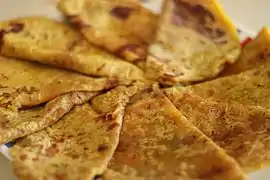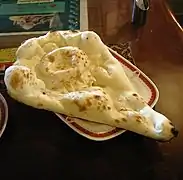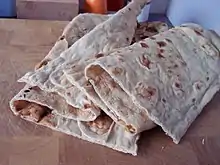Puran poli
Holige/Obbattu/Puran poli/Bobbattu is an Indian sweet flatbread that originates from southern India.
 | |
| Alternative names | Bobbattu, Obbattu, Holige, Ubbatti, Vedmi, Poli, Puranachi poli, God poli, Pappu bakshalu, Bakshalu, Oliga, Abatulu. |
|---|---|
| Place of origin | India |
| Region or state | Andhra Pradesh, Karnataka, Gujarat, Maharashtra, Goa, Telangana, Kerala, Telangana and Tamil Nadu |
| Serving temperature | Hot |
| Main ingredients | Wheat Flour, Sugar, Chana, Ghee |



Names
The various names for the flatbread include Bobbattu or Baksham or Oliga in Telugu, Andhra Pradesh Holige or Obbattu in Kannada, Puran puri or Vedmi in Gujarati, Puran poli in Marathi, Uppittu in Malayalam and Tamil, Bhakshalu or Pole / Polae in Telugu, Telangana and Ubbatti or simply Poli in Konkani.
History
Its recipe (as Bakshyam) is mentioned in Manucharitra, a 14th-century Telugu encyclopedia compiled ,hailing from present-day Andhra Pradesh.[1]
Ingredients
Holige is made from Channa, Plain flour (wheat flour), Jaggery or Cane Sugar, Cardamom powder and/or Nutmeg powder, Ghee and Water. Sometimes Toor dal is used in Gujarat. It is commonly used in the state of Karnataka and Tamil Nadu as well. In Andhra Pradesh and other places, Moong dal, Chana or a mix is used. Other ingredients that may or may not be used are: Nuts, Dates, Turmeric powder.[2][3]
Nutritional value
The predominant ingredients are Chana, Plain flour, Jaggery or Sugar.
1. Chana: It is a variant of Chickpea. It provides Fiber, is a major source of Protein, may help reduce Cholesterol and also contains Zinc, Folate and Calcium.[4] Toor dal can be used in place of chana dal and it has similar properties as of Chana dal.
2. Plain flour, Jaggery or Sugar: These are the major sources of Carbohydrates. While plain flour adds Complex carbohydrates, Jaggery and Sugar are Simple carbohydrates.
Regional variants
The method of preparation varies from place to place. There are many varieties of Obbattu including peanut, sugar, coconut, sesame and groundnut flavors. Sometimes grated coconut is added in Konkan, Maharashtra. Coconut palm jaggery may be used. Similarly, a mix of sugar and jaggery can be used as a sweetening agent. Normally nutmeg is used as a flavoring along the coast which is replaced by cardamom or sometimes both elsewhere. Methods of rolling the stuffed dough also differ. It can be rolled using rice flour which makes the rolling very convenient. In some recipes flour is not used at all; oil or ghee is used to roll it into a flatbread instead. The rolled bread can be roasted with or without any ghee or oil, which sometimes is smeared after its completely cooked. In some places, all-purpose flour dough is used after adding a pinch of turmeric which gives it a traditional yellow color. The dish is produced using a sweet filling inside flour dough. This is then rolled out and cooked on a hot griddle, usually with ghee.[5]
The size and thickness of puran puri also vary greatly, in Gujarat where the stuffing used is toor dal, it will be small in size and thickness will be more, whereas in holige with coconut stuffing it will be larger in size and with less thickness.
Andhra Pradesh
This dish has its origin in Andhra Pradesh. It is popularly called as Bobbattu .This is served on major festive and other occasions. It is one of the famous sweets of Coastal Andhra. The stuff used inside the Bobbattu varies according the region. It is served hot and eaten by applying a layer of Ghee to it. Rava Bobbattu is another varaiant of bobbattu. It is called as Poli in Rayalaseema region of Andhra Pradesh and Obbattu in northeast Andhra Pradesh.
Karnataka
It is a special dish served in the state of Karnataka on all occasions, especially during Yugadhi/Ugadi. Different varieties of Holige are served in various parts of Karnataka and the most common is the one prepared with yellow gram and sugar or jaggery and obbattu is also prepared using coconut and sugar as the ingredients.
Maharashtra
It is also the special dish of Maharashtra which is prepared on every occasion at every house especially during festivals such as Ganesh Chaturthi and Holi. It is eaten with Basundi, Aamras, Kadhi, Amti, etc. In Pune, Puran Poli is eaten with a variant of Amti (flavored sour curry) known as Katachi Amti is prepared with the remaining water of Chana Dal used to make Puran. In the Vidarbha region of Maharashtra, in puran poli use Gud For Sweet Taste, it is eaten with Wada - a pakora made of all lentils. [6]
Tamil Nadu
Opputtu in Tamil Nadu is a golden yellow sweet pancake from Tamil Nadu. It is eaten during a traditional Sadhya along with Payasam. Several varieties of opputtu are prepared including thenga (coconut) boli and sharkara (brown sugar). Opputtu is especially famous in the southernmost districts of Tamil Nadu and Kerala, India.
Opputtu is eaten mostly after lunch or as an evening snack. Opputtu looks like a flattened chapati and is golden yellow in color. It is popularly sold in trains by the hawkers. "Kadambur opputtu" is famous and it is available in coconut and brown sugar flavors.
Varieties of opputtu are available throughout the Deccan states.
See also
References
| Wikimedia Commons has media related to Obbattu. |
- K.T. Achaya (2003). The Story of Our Food. Universities Press. p. 85. ISBN 978-81-7371-293-7.
- Puran Poli
- "How to make Puran Poli". Sanjeev Kapoor Recipes. Retrieved 16 August 2020.
- S, Pooja (6 November 2014). "Healthy And Nutritious Tips: Health Benefits of Chana Dal". Healthy And Nutritious Tips. Retrieved 17 November 2017.
- "Bele Holige / Obbattu". Kannada Cuisine. Retrieved 27 December 2012.
- https://laxmis-puran-poli.business.site/



